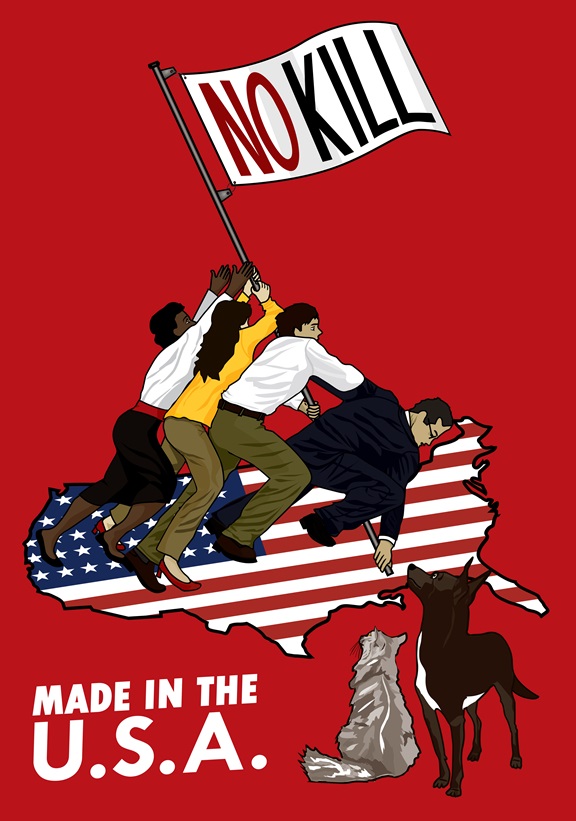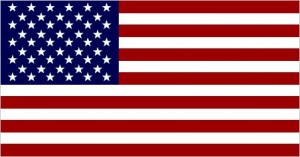
By Nathan & Jennifer Winograd
There is a solution to shelter killing in the U.S. and it is neither difficult, expensive, nor beyond practical means to achieve. We know how to end the killing and, in communities of every size, wealth, and demographic, we’ve done just that. As more shelters comprehensively embrace the programs and services of the No Kill Equation, they are saving lives on an unprecedented scale, upwards of 99% of all impounded animals. So why are some advocates still acting as if solutions to U.S. shelter killing are still unknown? And why are they looking across the globe for an answer when we’ve already found it right here at home?
Fed by the social media’s equivalent of the game “Telephone,” a whole series of myths has evolved regarding No Kill success in other countries. On Facebook comments, in blogs, in workshops, at conferences, and on websites, some advocates have been suggesting that U.S. shelters should model themselves after three other countries, each with their own distinct model of success: the United Kingdom, Germany, and Canada (Calgary, more specifically). But are these rumors true? Do these countries hold the keys to ending shelter killing in the U.S.? In fact, a closer look at the claims being made shows that they do not.
England’s Private Shelters

To some advocates, the roadmap to end killing in the U.S. lies in England. According to proponents of this model, England shelters are No Kill because they are private, run by organizations like the Royal SPCA, and the U.S. should follow suit and turnover day to day operations of municipal shelters to private organizations. The problem? We already have this scenario in many U.S. communities where private SPCAs and humane societies run animal control by contracting with local government to do so, and the vast majority of those shelters are far from No Kill. Nor should any one suggest that our nation’s equivalents to the RSPCA—HSUS and the ASPCA—be tasked to run our nation’s shelters, either. Not only are many kill shelters currently run in line with their regressive policies which favor killing, such as policies dictating the killing of animals even when there are empty cages, but both those organizations are stalwart opponents of No Kill, not champions of it.
In the U.S., it doesn’t matter whether it is a private SPCA or government agency running animal control: both can be regressive; both can and have achieved No Kill. The name or affiliation of an organization does not influence an agency’s success, only its commitment to lifesaving does. And of the dozens of communities in the U.S. with save rates between 90 and 99%, there is no correlation between that rate of lifesaving and whether that agency is a private SPCA or government-run. In fact, a survey of animal control funding and save rates found that government agencies tended to have higher save rates that private SPCAs doing animal control.
Moreover, and most important of all, the entire argument is based on the myth that the U.K. is No Kill. It most certainly is not. The RSPCA shelters kill half of all animals, similar to U.S. rates, and pit bulls are banned, resulting in an automatic death sentence for those dogs even when, as U.K. officials admit, the dog “isn’t acting dangerously” and “there hasn’t been a complaint.” In the U.K. “Whether your dog is a banned type depends on what it looks like, rather than its breed or name.” Tragically, the U.S. is already like the U.K. and millions of animals are losing their lives because of it.
Germany’s “Mandatory Spay/Neuter Law”

To other advocates, the roadmap for U.S. shelters lies in Germany. According to proponents of this model, Germany’s mandatory spay/neuter law is responsible for that country being a No Kill nation. The myth that Germany has a mandatory spay/neuter law and that this law is responsible for Germany’s lifesaving success comes from Cesar Millan who claims to have learned about the German system while he was in Spain. (If that doesn’t make sense to you, you are in good company.) According to Millan, what he learned when he was in Spain was that “in Germany, it is mandatory that you have to spay/neuter your dog.” As a result, dogs are not killed in German shelters and, according to some, there isn’t even a need for shelters. Of course, this ignores that Millan was only talking about dogs. What about Germany’s cats?
But this argument does not just exclude consideration of more than half of all the animals who enter shelters, it also happens to be untrue. In fact, Germany does not have a mandatory spay/neuter law, and its laws regulating dogs are not always progressive. In fact, some of them are downright draconian:
[C]ertain breeds of dog are NOT welcome in most German states. These breeds include: Pit Bulls, Staffordshire Bull Terriers and American Staffordshire Terriers. They are considered to be too dangerous. Their import to Germany is banned.
Some states, such as North Rhine-Westphalia, Bavaria and Brandenburg, also have a second category of dangerous dogs, called Kampfhund (combat or battle dogs), such as Rottweilers. These dogs are not banned altogether, but they must go through a test for viciousness. If they pass, then they are treated the same as any other breed of dog. But if they fail, they fall under the same rules as the category 1 of dangerous dogs, such as Pit Bulls.
Even if the category 1 dogs are not completely banned by your German state of residence, they (and you) will have to comply with strict rules: they must be neutered, muzzled and kept on a leash each time they are off your property, and the owner must pay a hefty licensing fee.
How is a model which mandates the death of some animals and draconian, unjustified restrictions on others a path to No Kill? Is this really a model we want to emulate in the United States? Ban certain breeds* of dogs (thereby enabling their mass killing) while subjecting others to discriminatory laws that implicate entire breeds of animals as dangerous with no regard for the individual or an animals’ true temperament?
It is our duty to nurture respect for animals, not inflame intolerance or the call to exterminate particular breeds. From the standpoint of those who love all dogs regardless of “breed,” the system in place in states like Brandenburg should not be seen as a model of compassion for the U.S. to emulate, but rather a call to arms for German dog lovers to reform their own nation’s regressive policies.
Moreover, mandatory spay/neuter laws are not a new or untested idea in the U.S. They have been around for decades and historically have been the favored form of pseudo-advocacy by the voices of tradition within the animal sheltering industry. In fact, many U.S. communities already have such laws. Are those communities No Kill? No, far from it. While mandatory spay/neuter laws have long been the siren song of the animal protection movement, the evidence proves that when implemented in the U.S., such laws have been disastrous. Over and over, mandatory spay/neuter legislation is pushed as a quick solution to high rates of shelter killing. “If only we had a spay/neuter law” the argument goes, “all the bad, irresponsible people would have to take care of their pets properly, and shelters wouldn’t have to kill so many animals.” If this were true, given the proliferation of such punitive mandates nationwide, these laws would have already created many No Kill communities. That there are none as a result of mandatory spay/neuter laws proves that such legislation does not work. In fact, it often has the opposite effect. Communities that have passed such laws are not only far from No Kill; they are moving in the opposite direction, killing more, not fewer animals.
Mandatory spay/neuter laws are a distraction not just because they fail to target the true cause of killing—the failure of a shelter to implement lifesaving alternatives—but because they don’t even succeed in forcing the behavior they theoretically exist to encourage. Studies show that people who do not spay/neuter are at the lowest rungs of the economic ladder—and that the vast majority would have their companion animals sterilized if it was affordable. That is why low-cost/free spay and neuter is a program of the No Kill Equation. Make it easy and affordable to do the right thing, and experience shows that people will. There is no need to bully or threaten people with impound and killing of their companion animals.
Furthermore, mandatory spay/neuter laws divert funding from true lifesaving programs—such as providing low-cost spay/neuter—and empower animal control officers to cite people with unaltered animals—people who often simply surrender the animals to avoid citation or the costs of sterilization. And because many of these communities do not offer an affordable alternative to the high fees charged by veterinarians, low-income people with animals cannot comply, while the laws may also empower these officers to forcibly impound those animals for not being sterilized. Because such shelters are following a punitive model of sheltering which places the blame for the killing on the public rather than a model which requires a shelter to implement alternatives to killing, animals impounded under these laws enter shelters where they face a high probability of death. In essence, when self-professed animal activists succeed in passing mandatory spay/neuter laws, they empower shelters—the number one cause of death for healthy dogs and cats in the United States—to impound, and therefore kill, more, not fewer animals. When the City of Los Angeles passed a mandatory spay/neuter law, not only did impound and killing of animals increase dramatically for the first time in a decade, but private practice veterinarians raised their prices because they now had a captive market required to sterilize their animals, putting sterilization for low income pet owners further out of reach. And because the pound made no effort to build the infrastructure to save those lives once they entered, more animals were killed—an all-too-common occurrence across the country.
Calgary’s Licensing Bylaw

And lastly, some advocates believe we should look to Calgary, Canada, where a model that focuses on dog and cat licensing is being credited for making Calgary a No Kill city. This argument requires a more detailed analysis than the claims about Germany and the U.K. for the simple fact that the claims made about those countries are untrue. Calgary, on the other hand, does have a save rate in the 90th percentile range.
That is great news for the animals of Calgary and evidence that Calgary must be doing something right. But what is that something? According to Calgary’s director in his tour of U.S. conferences, including Best Friends and HSUS, responsible pet ownership and a licensing model provide the roadmap for No Kill, a view which finds a willing audience among shelter directors looking to keep the focus of blame for the killing on the public, rather than themselves; as well as rescuers and others with whom the message of the “irresponsible public” being to blame for the killing continues to resonate. But does the Calgary model hold promise in the U.S.? No. In fact, it holds peril. Why?
First, cause and effect are misrepresented in the promotion of this model. The dog and cat licensing bylaws are not fully enforced. They may be used as a stick, but it is the carrot that ultimately prevails. And more importantly, the shelter has implemented alternatives to killing for the animals who do enter the shelter. How many shelters in the U.S. are open seven days a week and during evening hours when the working public and families with children can either adopt or reclaim lost animals? In Calgary, the shelter is open 10 am to 7 pm Monday through Friday and 10 am to 4 pm on Saturday and Sunday. How many shelters in the U.S. have animal control officers who drive animals home rather than impound them into the shelter? In other words, the programs and services that provide alternatives to killing for animals entering successful shelters in the U.S. are also in play in Calgary. In essence, it is the same model successful U.S. communities follow, with one variation: a discretionary enforcement of a punitive law that, ultimately, isn’t fully leveraged as it has been in the U.S. where such laws have proven dangerous.
In fact, licensing laws were not enacted in the U.S. to save lives, or to increase spay/neuter or reclaim rates. They were enacted as a tool for protecting animals raised and killed for food, enforcing rabies laws, and eliminating free-roaming dogs from public streets. Indeed, since their genesis, licensing laws have either explicitly or impliedly authorized the impoundment of unlicensed animals, and millions have been impounded and killed by animal control agencies throughout the country as a result.
Successful U.S. shelters have proven that we can dispense with the stick altogether and still achieve No Kill level save rates, without the danger of empowering our animal control agencies with greater authority to seize and impound animals. Conversely, U.S. shelters have demonstrated that when we empower our shelter directors with the discretion given to the Director in Calgary, killing is favored over lifesaving, and millions of animals are losing their lives every year because of it. In other words, Calgary’s director would succeed without the laws because the shelter has put into place lifesaving programs and policies for animals who do enter the shelter. A look at another Canadian community proves this to be so. Toronto is another community in Canada that requires both dogs and cats to be licensed. But unlike Calgary, 60% of all dogs and cats are losing their lives at the Toronto municipal pound. What is missing in Toronto? Alternatives to killing for the animals who do enter the shelter that animals in Calgary enjoy, combined with a shelter director who blunts the danger presented by the licensing law with discretionary enforcement that favors lifesaving.
Nor is it a good idea to empower progressive shelter directors in this country with this authority because there is no way of ensuring that such directors won’t leave. Directors come and go, but laws remain. When the Director in Calgary retires, what would happen if a less than progressive director is hired? The bylaws would be used as a weapon to end the lives of animals and the lifesaving policies and procures currently in place in the shelter may be abandoned (such scenarios are not without precedent in the U.S.). Under such circumstances, Calgary could become as regressive as Toronto. Activists who empower their community’s shelter director may come to bitterly regret such a move when their progressive director leaves, only to be replaced by one who is determined to enforce the letter of the law and/or is not interested in saving lives by maintaining the lifesaving infrastructure put into place by their predecessor, especially, as is in the case in Calgary, when the Director publicly credits laws, rather than the shelter’s own internal policies, for its success.
Discretion is a double-edged sword and when a typical U.S. (or Canadian) shelter director is in charge, discretion kills. In the U.S., we should be working to limit the discretion which empowers directors to kill, not to expand it. In fact, in the U.S. today, too much discretion for shelter directors—the ability to kill animals when there are empty cages, the ability to deny other non-profits the right to save animals they are planning to kill, the right to kill neonatal animals rather than send them into foster care, etc.—is why laws seeking greater shelter regulation are being introduced by informed and educated No Kill activists across the nation.
Lastly, believing that licensing alone holds the key to ending the killing perpetuates an overly simplistic and hopelessly misinformed understanding of the true cause of shelter killing. For even if licensing helped to limit rather than exacerbate killing as is actually the case, a look at the bigger picture of a shelter’s intakes illustrates how myopic it is to assume that such a mandate could ever be responsible for No Kill level save rates, addressing, as it does, such a limited sliver of the intake population at a shelter. Animals enter shelters for a variety of reasons and with a variety of needs. Some animals are feral, and have no human caretaker to claim or license them. How does licensing address the needs of these animals? With or without licensing, only the release of these animals back to their habitats will save these animals. Animals surrendered by caretakers who do not want them are not helped by licensing. They require the protection afforded by a comprehensive adoption program that guarantees them a new and loving home. Sick, injured, and traumatized animals who enter a shelter require medical care and behavior rehabilitation programs, not licensing, to ensure that their needs are met. While neonatal puppies and kittens or animals in need of supplemental care require placement in foster, not licensing, to ensure their needs and survival. And the list goes on.
Without lifesaving alternatives in place to meet the needs of all animals entering a shelter, animals are killed instead. Ensuring that shelters have these programs in place is the model that has already proven successful in American communities throughout the nation, and the reason why this model is not only a logical one, but the model Calgary must be following, as well. In short, the No Kill Equation is saving lives in Calgary because it, and not licensing, provides the alternatives necessary to actually replace killing.
Indeed, believing that punitive laws to promote “public responsibility,” such as mandatory spay/neuter or licensing, hold the key to ending the killing fails to recognize the most essential and tragic truth about animal sheltering in America today: there are already alternatives to killing but most shelter directors refuse to implement them. And how can you save animals in a shelter run by a director who simply refuses to stop killing? You can’t. Animals are not dying because of actions taken by the public which licensing laws attempt to address, but because of the choices made by people running our shelters, choices which only the implementation of the No Kill Equation can ensure are the right ones.
Real and Make Believe

If a solution to shelter killing in the U.S. was still unknown, seeking a method of ending the killing by looking to see what other countries may or may not be doing and how that impacts their rate of lifesaving would be the logical, and responsible, thing to do. But in light of the very real and proven solution we already have that is so willfully ignored in favor of misunderstood or untrue claims about the success of other countries, such efforts reek of a last ditch, desperate attempt to revive the fading supremacy of a century old punitive sheltering model responsible for the killing of millions of animals in U.S. shelters every year, rather than an honest attempt to illuminate the discussion of shelter killing in an honest, fact-based way. To bring an end to the killing in the U.S. in the shortest time possible, thereby protecting the lives of as many animals as possible, let’s focus instead on what has been proven to work in the U.S., what has been proven not to work, and go from there.
At the heart of the No Kill philosophy is the understanding that all the reasons we have historically been given for why animals are being killed in shelters—there are too many for too few homes available, and that the American public is uncaring and irresponsible—have been proven wrong in the face of communities that are achieving No Kill level save rates not by changing the habits of the people within a community, but by changing the culture, policies and procedures of the shelter itself. In other words, what changed was how the shelter operated, not the public.
Of course, that doesn’t mean we can’t learn from others or improve upon our efforts to save lives (such as the use of neuter-and-release for both cats and dogs in other countries). It just means that every animal lover has a responsibility to recognize that we don’t need to figure out how to end the killing anymore. It is no longer a mystery—the No Kill Equation provides the answer. Rather, our job as responsible animal activists requires us to promote proven solutions while exposing the fallacy of the historical misperceptions that have condoned and enabled shelter killing for so many decades. Our job is to make sure that the roadmap we already have is implemented nationwide so that every animal in every America shelter enjoys the love, protection and helping hand that our country’s most successful communities have already proven, time and again and unequivocally, are possible.
—————-
* As used by shelters, law enforcement agencies and courts, moreover, “Pit Bull” is not a breed of dog. It is, according to a leading advocacy organization, “a catch-all term used to describe a continually expanding incoherent group of dogs, including pure-bred dogs and mixed-breed dogs. A ‘Pit Bull’ is any dog an animal control officer, shelter worker, dog trainer, politician, dog owner, police officer, newspaper reporter or anyone else says is a ‘Pit Bull.'”
For more information on licensing laws, click here.
For a quick primer on No Kill in the U.S., click here.
Have a comment? Join the discussion by clicking here.